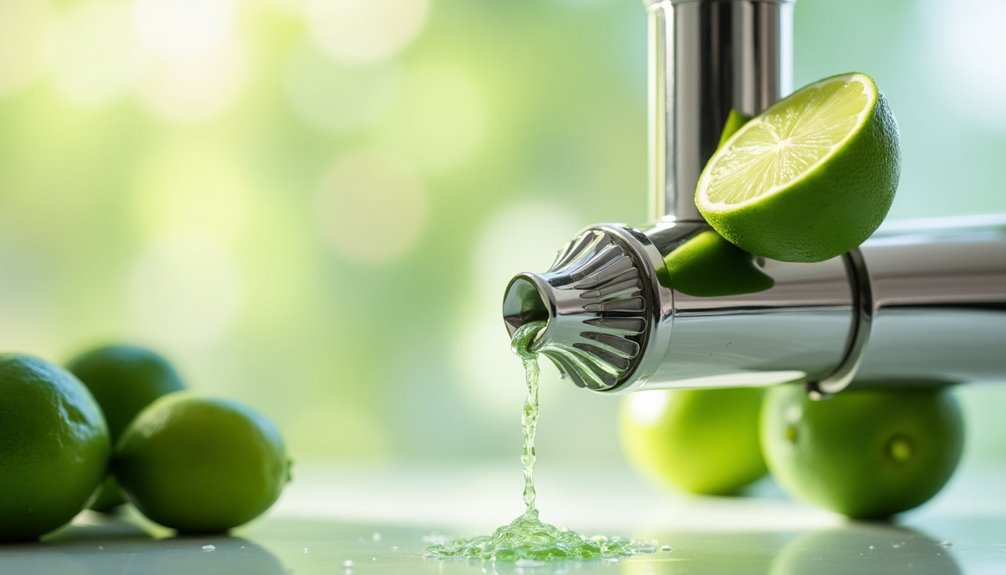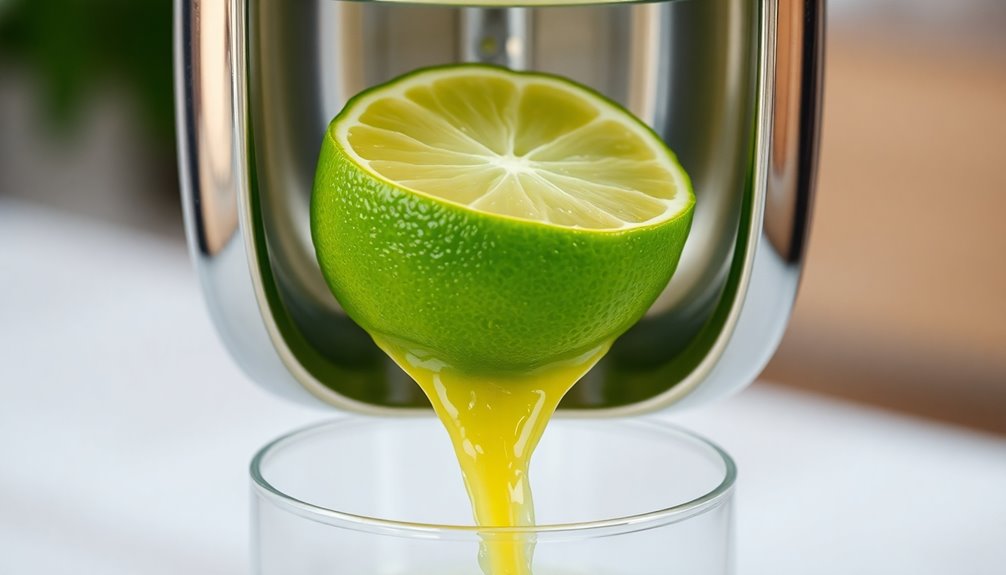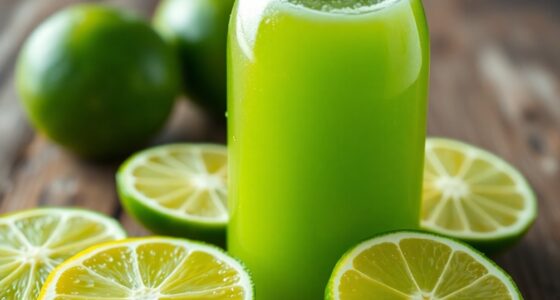To juice a lime in a juicer, start by cutting the lime in half across its width for easy juicing. Place the lime halves cut side down in the juicer to maximize extraction. Squeeze until no more juice flows out, using enough pressure to get every drop. For better yield, you can microwave the lime halves for 15-20 seconds before cutting. This simple process enhances your recipes, and there's more to learn about optimizing lime juice!
Key Takeaways
- Cut the lime in half across the width to expose the flesh for easier juice extraction.
- Place the lime halves in the juicer with the cut side facing down for maximum juice yield.
- Squeeze the juicer firmly until no more juice flows out, ensuring all liquid is extracted.
- For optimal yield, microwave the lime halves for 15-20 seconds before cutting to soften the fruit.
- One medium lime yields about 2 tablespoons of juice; expect to use 8-9 limes for a cup of juice.

Juicing a lime is a simple process that can enhance your favorite dishes and drinks. Whether you're adding a zing to your guacamole, brightening up a cocktail, or giving an extra kick to a marinade, fresh lime juice is a fantastic ingredient.
To juice a lime effectively, using a juicer can make the task easier and more efficient. Let's walk through the steps to ensure you get the most out of your limes.
First, you'll need to cut the lime. Take a medium lime and slice it in half across the width. This exposes the flesh, making it easier for the juicer to extract the juice. You'll want to ensure you're cutting the lime properly; a clean cut will help you maximize juice extraction.
Once you've cut the lime, you'll have two lime halves ready for juicing.
Next, place the lime halves in the juicer with the cut side facing down. This positioning is crucial because it allows the juicer to press against the juicy flesh directly, maximizing juice extraction. If you put the lime halves in the wrong way, you might end up with less juice than you could get. So, make sure the cut side is down!
Now, it's time to juice. Squeeze the juicer until no more juice flows out. It's important to apply enough pressure to ensure you extract all the liquid, leaving behind just the dry pulp. You may be surprised at how much juice you can get from just one medium lime, which typically yields about 2 tablespoons of juice.
If you're aiming for a larger quantity, like a cup of juice, you'll probably need around 8-9 limes.
For optimal results, consider giving the lime halves a quick blast in the microwave for 15-20 seconds before you cut and juice them. This step softens the fruit and can significantly increase juice yield. A little warmth makes the juice flow more freely, giving you every last drop of that fresh lime juice.
Once you've juiced all your limes, you can enjoy the vibrant taste and aroma that fresh lime juice brings. Whether you're mixing up a refreshing drink or enhancing a savory dish, using a juicer streamlines the process and helps you achieve the best results.
Frequently Asked Questions
Do You Have to Peel a Lime Before Putting It in Juicer?
You don't have to peel a lime before putting it in a juicer. The juicer can handle the whole fruit, including the rind.
In fact, leaving the peel on can add a unique flavor to your juice. Just make sure to wash the lime thoroughly to remove any pesticides or wax.
If you're using a manual juicer, simply cut it in half, and let the juicer do the rest!
What Is the Best Way to Cut a Lime for Juicing?
Did you know a standard medium lime yields about 2 tablespoons of juice?
To get the most out of your lime, cut it lengthwise beside the stem to create two halves. This method helps expose more juice. By doing this, you’ll not only maximize the juice yield but also make it easier to squeeze the halves directly into your recipes or drinks. If you’re wondering how to prepare homemade lime juice, simply take those freshly cut halves and use a juicer or your hands to extract the liquid. This simple technique ensures you get every last drop of flavor from your limes, perfect for dressings, marinades, or refreshing beverages.
You might also want to roll the lime on the countertop before cutting; it loosens the membranes, making juicing easier.
Removing a small piece of rind before juicing can further enhance juice extraction.
Enjoy squeezing!
How to Juice a Lime Without a Squeezer?
To juice a lime without a squeezer, start by rolling the lime on the countertop to loosen its membranes.
Cut it lengthwise into four pieces, making sure to catch the juice in a bowl. Squeeze each piece over the bowl, twisting the core to get every drop.
If you need more juice, poke a fork into the segments and twist. For extra extraction, consider microwaving the lime for 15-20 seconds before juicing.
What Is the Most Efficient Way to Juice Limes?
To juice limes efficiently, start by storing them in an unsealed plastic bag in the fridge.
Let them warm to room temperature before juicing.
Cut the lime in half, removing a small piece of rind to boost juice extraction.
If you want even more juice, microwave the lime for 15-20 seconds.
Remember to press the lime with the rind side down to maximize the flow while juicing.
Using multiple limes can yield greater amounts.
Conclusion
Juicing a lime is like unlocking a treasure trove of flavor, infusing your dishes and drinks with zesty brightness. With just a few simple steps, you'll transform that vibrant green orb into a refreshing burst of juice. Whether you're crafting the perfect margarita or adding a splash to your favorite dish, the effort is as small as a lime seed. So go ahead, embrace the tangy magic of lime juice and let your culinary creativity soar!
Cindy thoroughly researches juicing trends, techniques, and recipes to provide readers with practical advice and inspiration. Her writing style is accessible, engaging, and designed to make complex concepts easy to understand. Cindy’s dedication to promoting the advantages of juicing shines through her work, empowering readers to make positive changes in their lives through the simple act of juicing.











